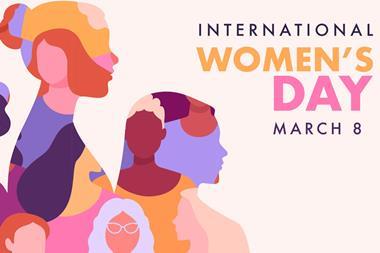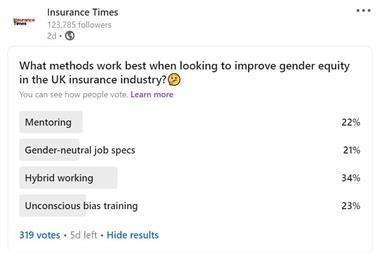Aviva’s group chief executive says ’it’s a disgrace that in the UK today, people’s futures are still dictated by their birth or by their life experiences’
Amanda Blanc, group chief executive of insurer Aviva, is urging the insurance industry to engage with the ABI’s recently launched diversity, equity and inclusion (DEI) blueprint in a “meaningful way” in order to move the needle on gender representation.
The ABI published its new blueprint on 22 November 2022 - the same day that the association held its Diversity, equity and inclusion summit: Driving change in our sector. The blueprint outlines a multiyear strategy that sets out priority areas for the ABI to focus on, good practice for the industry around DEI and opportunities for collaboration with experts.

Speaking on this during her keynote address at the conference, Blanc told delegates: “It’s a disgrace that in the UK today, people’s futures are still dictated by their birth, or by their life experiences.
”People are being denied the life they deserve, the careers they want and the experiences they crave all because we can’t get it together to change our businesses.
“Frankly, that’s a disgrace and a burden that I don’t think any of us want to be carrying a moment longer.”
She explained that as businesses are operating in a very volatile macroeconomic and geopolitical environment today, the best talent will be needed - regardless of creed, colour or gender.
Giving the ABI’s blueprint her support, Blanc urged: “My ask of every one of you is to use [this blueprint] properly, use it strategically.
”Please don’t tick box it – that’s easy. And that is why we have had a 0% improvement in gender diversity across all financial services,”
Blueprint support
The ABI’s blueprint is not the only DEI strategy document that Blanc has helped signpost.
Blanc liaised with global management consultancy Bain and Company and the government’s Women in Finance Charter Accountable Executive Taskforce to publish the Women in Finance Blueprint in March 2022.
This is closely tied to Blanc’s role as Women in Finance Champion - she was appointed to this post by HM Treasury in March 2021, suceeding Dame Jayne-Anne Gadhia.
The government’s Women in Finance Charter was launched in 2016 by HM Treasury following a review into the representation of women in senior managerial roles in financial services. It aims to tackle unequal gender representation in the financial services industry, especially within senior and mid-level management positions.
The charter is voluntary and companies choose to participate by publicly committing to improve gender inequality in their organisation by implementing set measures outlined by the charter.
Diversity journey so far
When working on the Women in Finance Blueprint, Blanc noted that the insurance industry was “further back than we had imagined” - however, she told the ABI’s delegates that this ”wasn’t a negative”.
She continued: “It was a huge positive as we now [had] a true understanding of where we are with gender diversity – where it was good, or where it was bad. What was working? What wasn’t? It gave us our very own blueprint for change. A genuine change is now taking place.”
According to the blueprint, senior representation of females in financial services was 31.5% in 2018 - this increased at a rate of 1% to 2% until 2020, where this figure hit 32.3%.
Blanc predicted that it will take 30 years to reach gender parity by 2050, where the senior representation of females in financial services is 50%.
The Women in Finance Blueprint is based on interviews with chief executives in financial services, Bain and Company’s analysis, academic research, cross-industry case studies and a survey of more than 100 signatories.
The blueprint is based on four pillars – recruitment, retention and promotion, culture and behaviour and embedding DEI.
Within the report, information around each pillar includes a case for change, detailed policy actions, best in class case studies and chief executive questions.
The blueprint has been designed to apply to organisations of any size, to tackle any DEI objective. Aviva, for example, is focused on gender parity, Blanc said.
Read: ABI creates blueprint for DEI future
Read: Aviva invests $10m in Female Innovators Lab Fund
Read: Blanc succeeds Gadhia as new Women in Finance Champion
Explore more diversity and inclusion content here and discover more news content here
The insurer intends to conduct the exact same blueprint exercise internally because Blanc believes that blueprints for change do work.
“I’ve seen that happen in real-time and I urge all of you to take [blueprints] very seriously because diversity in the workplace is a hugely important issue. Of course, there’s a moral imperative,” she said. “The reality is we all need to bring pressure to bear on our organisations.”
Blanc added that DEI has to be ”a strategic priority” that ”is supported and measured like any other initiative”.
She continued: “If we can do that, perhaps we can finally start making this the kind of profession where everyone feels they belong, are valued, can contribute and, ultimately, lead the profession in the next 300 years of history.”
Hosted by comedian and actor Tom Allen, 34 Gold, 23 Silver and 22 Bronze awards were handed out across an amazing 34 categories recognising brilliance and innovation right across the breadth of UK general insurance.




















































No comments yet